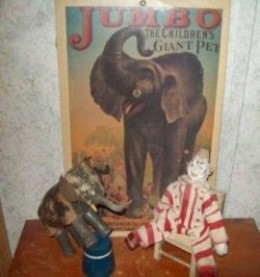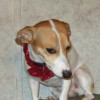The Humpty Dumpty Circus - Schoenhut's Masterpiece
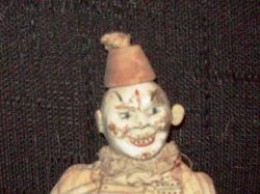
There is Something For Everyone Under the Big Top
Many years ago as a young child I saw a picture of the Schoenhut Humpty Dumpty circus. I was completely enchanted by this elaborate toy and desperately wanted one to play with. Of course, I was born too late to own one of these incredible playthings, a toy whose magic was only limited by the imagination of the lucky child who was fortunate enough to own one. As an adult, I found that I could recapture some of the magic of the Humpty Dumpty circus by collecting pieces whenever I was lucky enough to find one.
The Humpty Dumpty Circus was introduced by Schoenhut in 1903. The original set consisted of a clown, a chair, and a ladder. However, the clown was fully jointed and this simple set could be posed in numerous ways, limited only by the child's imagination.
Soon, the Schoenhut company began producing more figures to compliment this original set and it was possible to assemble a rather large circus. Available pieces included circus tents, circus wagons, performers, and a wide range of animals. These toys were produced until 1935.
Today, these wonderful toys are prized by antique collectors, doll collectors, and the young at heart! Even if you only own a few pieces, the display possibilities are unlimited, making this one of the most unique toys ever produced. One or two pieces of this amazing circus can bring out the child in anyone!
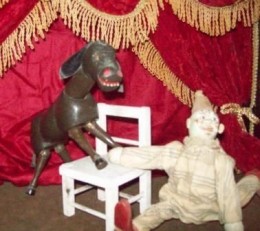
The Performers
Schoenhut manufactured a wide variety of circus performers which enabled a child to create an unlimited range of acts and scenarios. These performers came with jointed bodies that were able to hold a wide variety of poses including splits, handstands, and anything else a child could imagine! Most of them had heads made of wood, but some had bisque heads. Some of the performers included clowns (named Humpty, Dumpty, and Cracker Jack), Chinese acrobats, a lady acrobat, a hobo, a lion tamer, a lady rider, and a ringmaster. Since no circus is complete without music, they even had a band
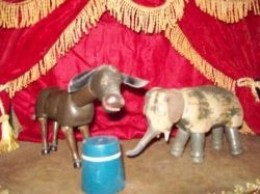
Performing Animals
A wide variety of animals were also produced. Some of these performing animals you would expect to find in a circus, such as the elephant, horse, donkey, or the camel. However some of the animals, such as the polar bear, the hyena, and the alligator, were not animals regularly seen in a circus.
Today, collectors prize the animals with glass eyes and they tend to cost a little bit more than the painted eye versions. However, the animals with painted eyes are also very charming and display equally well.
Have you ever seen The Humpty Dumpty Circus?
View an Incredible Schoenhut Circus Display Here!
The Menagerie
Just like the performers, the animals were jointed and could be posed in a wide variety of ways. The following animals were available for purchase. Most were available with either glass eyes or painted eyes.
- Alligators featured a lathe-turned wood body and two body styles were available.
- Brown Bears were available in five styles. They could be found with open or closed mouths. The body and leg design is the same on all styles of bears, but the heads could be formed either by hand or with a lathe.
- Early buffalo circus figures have been mistaken for a musk-ox. There are both open and closed mouth versions available. Some of the bison have fur glued on the head and shoulders and they have leather ears and horns. Both painted and glass eyed versions were available.
- Bulldogs were made in four body style. One version has deeply molded wrinkles in the face, giving it a unique look. They all have a leather collar, leather ears, and a leather tail.
- The burros all featured leather ears and a twisted twine tail. One adaptation of the burro comes with a chariot to pull in a circus parade!
- Camels were made with one hump or two humps. Some camels had open mouths while others featured closed mouths.
- The cats all came with horsehair whiskers. Some had carved ears while later cats had leather ears.
- Some of the cows were spotted while some were a solid color. They all had leather horns, leather ears, twine tails, and a leather collar.
- The deer all featured leather antlers.
- Donkeys were made in two styles. One had larger, flaring nostrils than the other one. They all had leather ears. A few can be found with a felt saddle.
- No circus would be complete without an elephant. Some had longer trunks than others, but they all had a rubber piece that curved on the ends of their trunks. A few came with a fancy blanket and a headdress.
- The gazelles featured leather horns, ears, and a tail.
- Four styles of giraffes were manufactured. Some had open mouths while others were closed. They had dowel horns, leather ears, and cord tails.
- Goats were manufactured in three body styles. All of the goats had leather horns and leather ears.
- The goose was made with painted eyes only. There were two styles of the goose available with the main difference being the head shape.
- The gorillas can be found in two body styles. One was a little shorter than the other.
- Three styles of the hippopotamus were manufactured. All had leather ears and tail.
- The horses were both white or dark colored. Some horses were equipped with a saddle while some had a small disk platform attached to their backs. The white horse was listed in early catalogs as "the Beautiful Educated Horse."
- Hyenas came in two styles. Some had their stripes painted on with a brush while others were sprayed on. They have leather ears and a twine tail.
- Kangaroos were manufactured with leather ears on both eye styles.
- Leopards were available with molded or leather ears.
- While some of the lions had a furry cloth mane, others had manes that were formed on their bodies.
- The monkey came with a red felt costume and a hat. Some can be found with longer legs than others.
- Four styles of the ostrich were available and they had open or closed mouths. There were differences in the legs and feet of some of these birds.
- Some of the pigs produced had a wider snout than others. They all had leather ears and a curly wire tail.
- Polar bears were available to the consumer. Some had noses that were a little more pointy than others. They all had leather ears as well as a leather or cord tail.
- Poodles were made in four different styles. Some poodles had a cloth mane while others had manes that are molded on. The poodles also had slots in their feet that allowed them to walk a tightrope.
- Rabbits can be found in two different styles. The rabbits had leather ears and a short leather tail.
- Three styles of rhinos were made. They featured leather ears and a twine tail.
- Sea lions had leather ears and front flippers made of leather.
- The sheep came with a charming red ribbon and a bell around their necks.
- Tigers were available for purchase. The stripes were applied using a stencil.
- The wolf came with leather ears. Some wolves had molded wooden tails while some had fuzzy tails.
- There were two known styles of zebus. They had leather horns, leather ears, and a twine tail.
- Zebras had stripes that were applied with a stencil. They had leather ears and a cord tail.
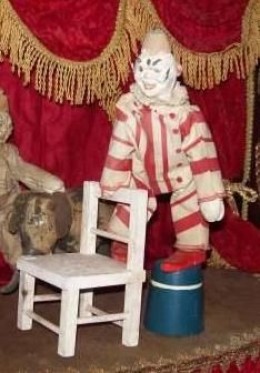
The Little Touches That Make All the Difference
Schoenhut manufactured a wide variety of accessories to compliment the circus figures. These included circus tents, wagons, chairs, hoops, pedestals, ladders, musical instruments, and animal cages. It is amazing how many scenes you can create with just a few of the accessories.
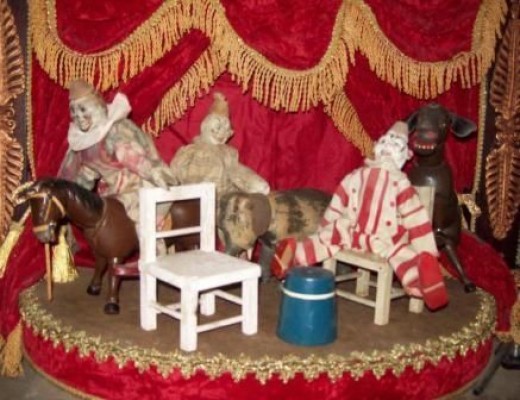
The Humpty Dumpty Circus Film - A Lost Treasure
In 1908, the Humpty Dumpty Circus was the subject of one of the first stop motion films ever made. The film by J.S. Blackman moved the various figures around one frame at a time, creating the illusion that they were moving.
Unfortunately, this is a lost film and there are no known copies available. It's unfortunate that we can no longer view this treasure.
